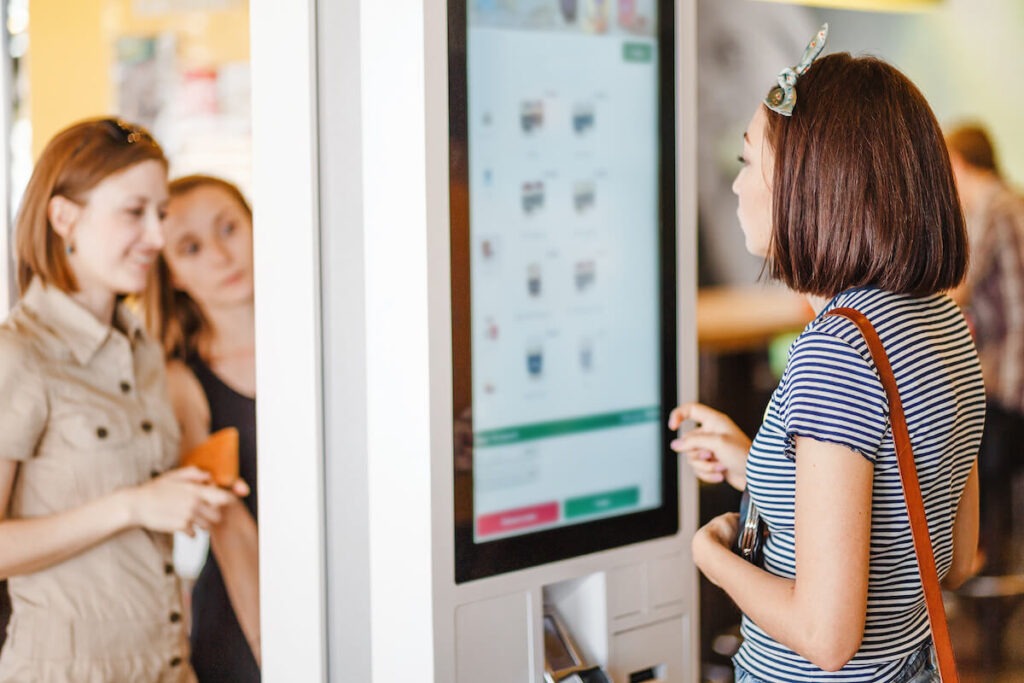- Voice AI solutions are a superior alternative to menu-based automated phone systems like interactive voice response (IVR), chatbots, call centers, and virtual assistants
- Legacy phone systems can’t match the benefits of conversational AI when it comes to scalability, quality of service, sophistication, speed and intelligence
- A conversational AI platform increases quick-service restaurant productivity and leads to greater profits because it can handle an unlimited number of calls at once and takes complex orders with incredible accuracy
Artificial intelligence (AI) solutions are everywhere in the business world, and the food service sector is no exception. The market size of restaurant AI solutions is on pace to grow by $5.66 billion by 2026.
It’s certainly not a coincidence that leading quick-service restaurants (QSRs) are gradually implementing conversational AI solutions to optimize their operational efficiency. While traditional phone systems have their place, they lack voice AI’s scalability, sophistication and ability to learn from experience. This article will discuss the differences between legacy phone systems and voice AI platforms, and explain why QSR operators will benefit from transitioning to conversational AI technology.
The weaknesses of legacy phone systems and similar technology

Although interactive voice response (IVR) phone systems, chatbots and related tech solutions were once cutting-edge technology, they’ve since been surpassed by voice AI technologies that provide superior performance and greater customer satisfaction.
Interactive voice response (IVR)
IVR systems are automated voice-over-internet-protocol (VoIP) solutions that greet callers and respond to simple queries. IVR systems reduce wait times when human agents are unavailable and also allow callers to use self-service tools, e.g., a numbered menu where pressing a digit on the phone keypad redirects the caller to the corresponding department or sub-menu. For example, a pharmacy IVR application can verify the caller’s identity and account information so they can quickly check their prescription status without the assistance of a team member. IVR comes with a host of limitations, however. We’ve all endured long, frustrating calls with automated IVR systems that can’t hear or understand your requests, or can’t assist you because your question is outside the scope of its programming. In contrast, calling into a voice AI system is just like talking to a live agent, where you can engage in standard conversation without needing to navigate through a limiting (and confusing) network of buttons to press.
Chatbots
Chatbots follow a scripted sequence of simple commands, using keywords to identify the correct response to user questions and statements. Chatbots allow businesses to provide 24/7 customer service at a low cost, saving companies up to 30% annually. Customer service chatbots are most suited to handle simple customer interactions such as tracking the status of overdue package deliveries. Chatbots aren’t resourceful enough to go off-script, so they’re best used only to handle FAQs and other quick and easy customer interactions. Conversational AI virtual assistants, however, aren’t bound to a set script: they recognize context clues in speech, and easily address complex questions.
Call centers
Call centers generally rely on live agents to provide callers with customer support, with occasional assistance from IVR virtual agents. Although the general public primarily turns to the internet to resolve customer service issues, there are still plenty of people who prefer to do so over the phone. IVR systems offer 24/7 customer support, and allows third-shift workers and other time-constrained customers to get the help they need even outside of standard business hours. Unfortunately, contact center turnover rates clock in at a staggeringly high 30-45%, resulting in staffing shortages and a stressful work environment. This in turn leads to excessive hold times, missed phone calls and an overall poor customer experience. This issue worsened over the past couple of years due to the pandemic-fueled surge in call volume and IVR phone systems’ inability to give customers the level of service they deserve.
Voice assistants
Digital voice assistants like Alexa and Siri might be the most recognizable and popular form of digital communications technology. In fact, Juniper Research predicts that by 2024, voice assistants will outnumber the global population. Voice assistants allow users to execute certain functions on their device using voice commands, e.g., scheduling a meeting on their calendar. Voice assistants have their limitations. For example, while Siri can tell you the name of that song playing on the radio, it’s only because Amazon gave her access to that information. On the other hand, conversational AI platforms are much more dynamic. They recognize ambiguities in users’ speech, and use context clues to better understand user intent.
Why leading brands are phasing out IVR for conversational AI

It’s a common misconception that conversational AI and IVR systems are one and the same, but in fact, voice AI is an all-new technology that makes IVR a thing of the past. Think of IVR as the first step that ultimately led to contemporary voice AI, much like rotary phones gradually evolved into smartphones.
How conversational AI beats out IVR
Conversational AI, also known as voice AI, uses natural language processing (NLP), natural language understanding (NLU) and machine learning algorithms to interpret and respond to speech, and to learn from these user interactions. This results in a feedback loop where the voice AI platform continuously refines the underlying algorithms. Put simply, voice AI makes every conversation better than the last. The end result is a product with way more potential than traditional phone systems and text-to-speech (TTS) devices.
No more navigating through seemingly endless menus and submenus or constantly repeating yourself because the IVR can’t hear you: groundbreaking conversational AI applications provide an excellent user experience. This is far superior to live customer service in many cases since conversational AI assistants provide callers with personalized attention and accurately fulfill their requests. Conversational AI platforms also handle unlimited calls simultaneously, meaning shorter lines, zero hold and wait times and no risk of missed calls.
IVR phone systems are menu-based applications that route callers to specific departments (e.g., tech support) and assist with simple requests like checking a bank account balance. IVR compensates for high call volumes by handling incoming callers when live agents aren’t available. Unfortunately, even comprehensive menu trees aren’t necessarily detailed enough to satisfy customer needs.
Voice AI and conversational IVR QSR applications

Missed calls, long wait times and inaccurate orders cost restaurants money and reputation. A restaurant that uses voice AI won’t suffer these issues since voice AI assistants automatically answer every call that comes in and accurately records guest orders in real-time. Conversational AI also improves order fulfillment speed and increases total ticket sales from phone orders. Additionally, operators can reassign team members to food preparation or other tasks, leading to greater productivity.
Forward-thinking QSR operators continue to transition to voice AI for one simple reason: it’s unequaled by anything that’s come before. Conversational AI increases restaurant revenue through automated, strategic upsell by analyzing menu item combinations, guest order flow and the brand’s specific upsell preferences. Restaurant virtual ordering assistants effortlessly receive and record orders, nearly doubling peak-hour volume while giving guests personalized and friendly service.
In contrast, IVR telephony simply can’t come close to matching voice AI’s performance. While traditional IVR systems adequately perform simple customer service actions, their menu-based structure is a poor fit with the complexity of restaurant operations. For example, if a guest wants to change a submitted order or has questions about ingredients or nutrition content, IVR won’t be able to satisfy their needs.
Conversational AI systems lead to a superior guest experience

Taking advantage of emerging technology and new business strategies is an essential part of running a successful QSR operation. Leading QSR brands are phasing out IVR and call centers in favor of conversational AI for its superior performance. Voice AI is one of the fastest-growing categories in the restaurant industry, with the country’s leading restaurant brands adopting and implementing the technology into their operations.
It’s not too late to stay ahead of the curve. ConverseNow’s award-winning voice AI technology has revolutionized operations for some of the nation’s top QSR brands and their franchisees, currently live in more than 1,200 stores across 43 states. Discard your restaurant’s antiquated phone systems and switch to conversational AI for a step into the future. Schedule a demo today with ConverseNow.




